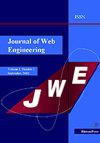Code Smell-Guided Prompting for LLM-Based Defect Prediction in Ansible Scripts
IF 1
4区 计算机科学
Q4 COMPUTER SCIENCE, SOFTWARE ENGINEERING
引用次数: 0
Abstract
Ensuring the reliability of infrastructure as code (IaC) scripts, like those written in Ansible, is vital for maintaining the performance and security of edge-cloud systems. However, the scale and complexity of these scripts make exhaustive testing impractical. To address this, we propose a large language model (LLM)-based software defect prediction (SDP) approach that uses code-smell-guided prompting (CSP). In some cases, CSP enhances LLM performance in defect prediction by embedding specific code smell indicators directly into the prompts. We explore various prompting strategies, including zero-shot, one-shot, and chain of thought CSP (CoT-CSP), to evaluate how code smell information can improve defect detection. Unlike traditional prompting, CSP uniquely leverages code context to guide LLMs in identifying defect-prone code segments. Experimental results reveal that while zero-shot prompting achieves high baseline performance, CSP variants provide nuanced insights into the role of code smells in improving SDP. This study represents exploration of LLMs for defect prediction in Ansible scripts, offering a new perspective on enhancing software quality in edge-cloud deployments.可行脚本中基于llm的缺陷预测的代码气味引导提示
确保基础设施即代码(IaC)脚本的可靠性,就像那些用Ansible编写的脚本一样,对于维护边缘云系统的性能和安全性至关重要。然而,这些脚本的规模和复杂性使得详尽的测试不切实际。为了解决这个问题,我们提出了一种基于大型语言模型(LLM)的软件缺陷预测(SDP)方法,该方法使用代码气味引导提示(CSP)。在某些情况下,CSP通过将特定的代码气味指示器直接嵌入到提示符中来增强LLM在缺陷预测方面的性能。我们探索了各种提示策略,包括零提示、单提示和思维链CSP (CoT-CSP),以评估代码气味信息如何改进缺陷检测。与传统的提示不同,CSP独特地利用代码上下文来指导llm识别容易出现缺陷的代码段。实验结果表明,虽然零射击提示实现了高基线性能,但CSP变体提供了对代码气味在改善SDP中的作用的细致见解。这项研究代表了在Ansible脚本中进行缺陷预测的llm的探索,为在边缘云部署中提高软件质量提供了一个新的视角。
本文章由计算机程序翻译,如有差异,请以英文原文为准。
求助全文
约1分钟内获得全文
求助全文
来源期刊

Journal of Web Engineering
工程技术-计算机:理论方法
CiteScore
1.80
自引率
12.50%
发文量
62
审稿时长
9 months
期刊介绍:
The World Wide Web and its associated technologies have become a major implementation and delivery platform for a large variety of applications, ranging from simple institutional information Web sites to sophisticated supply-chain management systems, financial applications, e-government, distance learning, and entertainment, among others. Such applications, in addition to their intrinsic functionality, also exhibit the more complex behavior of distributed applications.
 求助内容:
求助内容: 应助结果提醒方式:
应助结果提醒方式:


